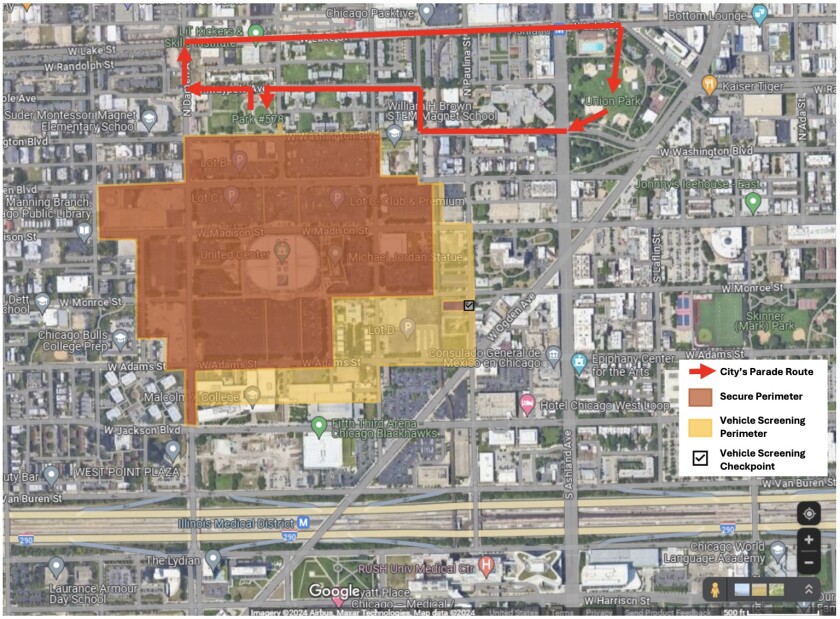DNC protesters vow to appeal after federal judge sides with City Hall on parade path
Conflicts over park permits and speaker slots outside the convention have also threatened to prolong the litigation. The convention begins Monday at the United Center and McCormick Place.
By Jon Seidel
Updated Aug 13, 2024, 5:46pm CDT

The legal battle over the protest path during Chicago’s Democratic National Convention could continue into the final days before the big event after leaders of high-profile demonstrations promised to appeal a federal judge’s ruling in favor of City Hall.
U.S. District Judge Andrea Wood late Monday said she would not force the city to alter the path it offered to groups aiming to protest the Israel-Hamas war, finding that the city had satisfied the First Amendment while addressing significant security and safety concerns.
The challenges made in court boil down to complaints that City Hall has “not offered the exact route” protesters desire, even though it “allows them to speak near their intended audience,” Wood concluded in her 24-page ruling.
Coalition to March on the DNC spokesperson Hatem Abudayyeh promised Tuesday that an appeal would be forthcoming, though it had not appeared on the court docket that afternoon.
Abudayyeh could not say whether the protest groups would abide by Wood’s decision should it stand at the end of such an appeal. Rather, he said the protest groups would use their “considerable political power” over the next five and a half days to secure a more accommodating route.
“If we don’t, there will be a decision by the Coalition by then,” he said.
Conflicts over park permits and speaker slots outside the convention have also threatened to prolong the litigation. Wood spoke with lawyers in the case Tuesday, and she scheduled another hearing Thursday to potentially deal with such matters.
The convention begins Monday at the United Center and McCormick Place.
Those suing over the route include the Chicago Alliance Against Racist and Political Repression, the Anti-War Coalition, Students for a Democratic Society at UIC and the United States Palestinian Community Network. Their attorneys have predicted up to 25,000 people could participate in their demonstrations.
Chicago Police Supt. Larry Snelling was asked during a separate event Tuesday how officers would handle protesters who slip out of the designated protest zones. He insisted officers would not arrest people who are obeying the law.
“If everybody is doing exactly what’s expected of them and exercising their First Amendment rights, this is not an arrest situation,” Snelling said.“We want people to exercise their First Amendment rights. We will protect them while they’re doing it. But we will not guarantee someone that we’re not going to make arrests if they act violently or start to commit crimes.”
City Hall previously tried to steer protests three miles east of the United Center, to Columbus Drive in Grant Park. Then in early June, city attorney Andrew Worseck told the judge it planned to offer a route that is “United Center adjacent.”

City Hall offered a parade route that begins at Union Park and follows Washington west to Hermitage, then north to Maypole, west to Park 578 and then to Damen, north to Lake Street and then concludes at Union Park.
The groups weren’t satisfied and asked the judge to force the city to adjust further. Specifically, they argued that the turns onto Hermitage and Maypole would create a logjam that would bring the march “to a standstill.” They’ve said the marchers should be allowed to continue west on Washington to Oakley or Western.
The city said the demonstrators can’t continue along Washington because fencing for the security perimeter around the United Center would likely be erected somewhere in that street, creating a potential safety hazard. On Monday, Wood agreed.
“Simply put, allowing a crowd of that size (or even a smaller one) to march directly alongside an unyielding barrier — no matter how much of the street is available for pedestrian use — poses an obvious risk of injury,” Wood wrote in her ruling.
The judge said she was also persuaded by City Hall’s arguments about the need for emergency services to access the area around the United Center. And she said there was no evidence that the turns in the parade route will be as problematic as has been predicted.
“Even assuming the protest parades draw as many people as [the protest groups] expect, they cite no prior event precedent or other evidence suggesting that such a crowd could not navigate the two turns onto Hermitage Avenue and Maypole Avenue,” Wood wrote.
This article was originally published by the Chicago Sun-Times.